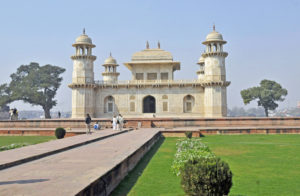
Tomb of I’timād-ud-Daulah in Agra (Photo by Don Knebel)
I’timād-ud-Daulah (“Pillar of the State”) was born in Iran as Mirza Ghiyas Beg. Seeking a better life, Beg took his young daughter, later known as Noor Jahan, to India, where he because an important member of the court of Akbar, the great Mughal emperor. Noor Jahan, said to have been the most beautiful woman in India, became highly educated and cultured. While married to a soldier, she caught the fancy of Jahangir, Akbar’s son. Recalling the story of David and Bathsheba, when Jahangir became emperor upon the death of his father, Noor Jahan’s husband was killed in battle and Jahangir then married the object of his desire. Noor Jahan, Jahangir’s favorite wife, dominated her weak husband, becoming the “power behind the curtain” during the glory days of the Mughal Empire.
When I’timād-ud-Daulah died in 1622, his daughter ordered the construction of an elaborate tomb for him and her mother along the banks of the Yamuna River. The tomb, with octagonal minarets on each corner, was completed six years later and sits in the middle of a garden divided into quarters by intersecting water channels symbolizing the four rivers of life in Paradise. Unlike earlier Mughal tombs and palaces, which were constructed of red sandstone, I’timād-ud-Daulah’s tomb was built of white marble, inlaid with glistening semi-precious stones. Four years after Noor Jahan completed her parents’ tomb, her step-son, Mughal Emperor Shah Jahan, drew heavily on its novel features in building the Taj Mahal as the tomb for Mumtaz, his favorite wife. When you visit the Taj Mahal, don’t overlook its shining inspiration less than four miles away.
Comments are closed.